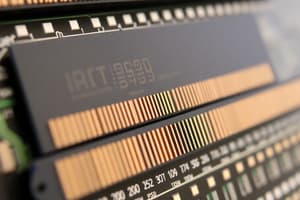Podcast
Questions and Answers
What is the last on the hierarchy scale of memory devices?
What is the last on the hierarchy scale of memory devices?
- Secondary memory (correct)
- Cache
- Main memory
- Flash drives
Which memory type is a random access memory?
Which memory type is a random access memory?
- Associative memory
- Virtual memory
- Cache memory
- Main memory (correct)
Which memory access method allows access in a sequence or in order?
Which memory access method allows access in a sequence or in order?
- Sequential access (correct)
- Cache access
- Random access
- Direct access
Which memory access method stores information in tracks with separate read/write heads?
Which memory access method stores information in tracks with separate read/write heads?
Which memory type aims to obtain the highest access speed while minimizing the total cost of the memory system?
Which memory type aims to obtain the highest access speed while minimizing the total cost of the memory system?
Which memory type is at the highest level in the memory hierarchy scale?
Which memory type is at the highest level in the memory hierarchy scale?
What is the primary function of Memory Hierarchy?
What is the primary function of Memory Hierarchy?
Which memory access method allows access in a sequence or in order?
Which memory access method allows access in a sequence or in order?
Which memory type is a non-volatile storage medium?
Which memory type is a non-volatile storage medium?
Which memory access method uses unique addresses for each memory location?
Which memory access method uses unique addresses for each memory location?
Flashcards are hidden until you start studying
Study Notes
Memory Hierarchy
- The highest level in the memory hierarchy is Cache memory.
Memory Access Methods
- Sequential access allows access in order, retrieving data one after the other.
- Direct access uses unique addresses for each memory location, allowing direct access to any location.
- Content-addressable memory retrieves data based on its content, not its address.
Memory Types
- Random access memory (RAM) is a type of volatile memory that can be accessed randomly.
- Secondary memory is a type of non-volatile storage medium that is used to store data persistently.
Memory System Cost Optimization
- Memory hierarchy aims to optimize the total cost of the memory system by utilizing different memory types with varying access speeds and storage capacities. This involves using a faster but smaller cache memory to hold frequently accessed data, while slower and larger primary and secondary memories hold less frequently used data.
Data Storage Method
- Magnetic Disk is a common type of secondary memory that stores data on tracks with separate read/write heads.
Studying That Suits You
Use AI to generate personalized quizzes and flashcards to suit your learning preferences.




